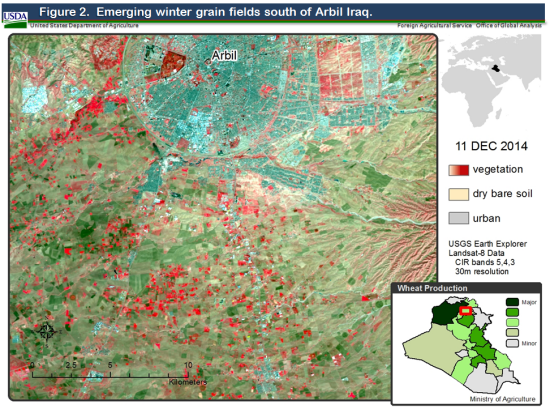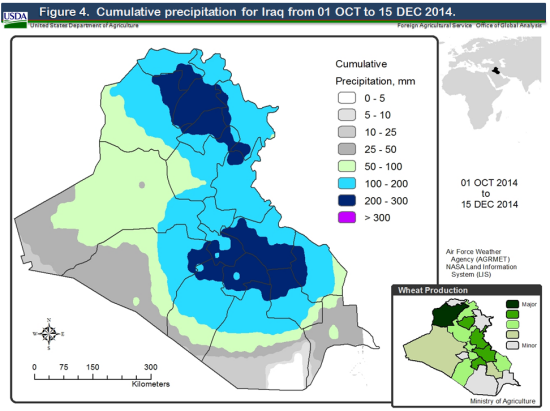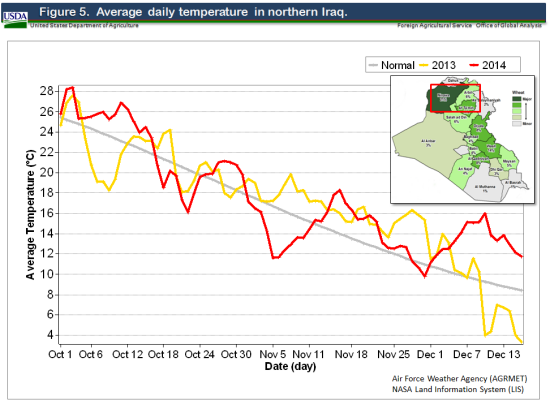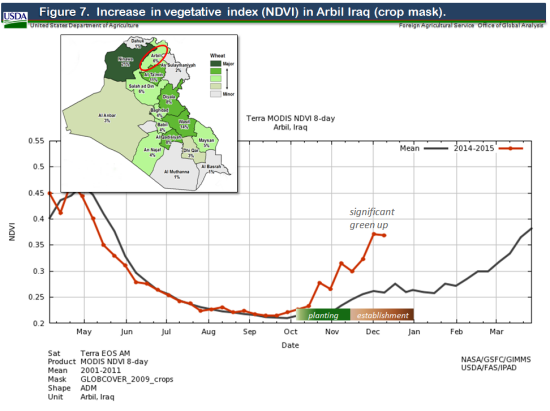Iraq’s 2015/16 Winter Grains Have Favorable Weather for Planting
Winter grains play an important role in Iraq’s food security. Wheat, the major winter grain, and barley are planted at the beginning of October until the end of November. Harvest usually begins in May and continues through June. In recent years wheat production has increased. USDA estimated the wheat crop harvested in 2014 (market year 2014/15) at a record 3.5 million metric tons due to high incentives to plant and very good weather conditions. Despite the record, wheat production remains below consumption and Iraq continues to import wheat. This year, however, planting in northern Iraq is occurring during civil disruptions. This article provides a review of satellite imagery and weather conditions for an update on winter grains.
Analysis of satellite imagery in northwestern Ninawa province showed evidence of plowing activity in early November 2014 (Fig. 1). Satellite imagery from December 2014 indicated fields of winter grain starting to emerge near Arbil in northern Iraq (Fig. 2). Both temperature and precipitation have been very favorable for the planting and establishment of a winter grains crop in northern Iraq. Cumulative precipitation for northern Iraq is well above normal and has so far exceeded the early season precipitation observed from last year (Fig. 3). A pattern of soaking rains followed by periods of dryness was sufficiently spaced apart so field work was not limited. Figure 4 is a map showing the distribution of the total precipitation from October 1 to December 15, 2014. The precipitation pattern placed the bulk of the rain over the major wheat growing areas. Daily average temperatures in the north have been mild, and would have allowed the crop to become well established since temperatures are still above the 2o C boundary at which point winter dormancy would set in (Fig. 5).
Vegetation response, as measured by satellite-derived normalized difference vegetation index (NDVI), to the favorable weather conditions is evident in Ninawa (Fig. 6), Arbil (Fig. 7), and to a lesser extent in At Ta’min (Fig. 8) These positive vegetation values suggest that winter grains are becoming well established in northern Iraq. Important central and southern wheat growing areas (Salah ad Din, Diyala and Wasit), however, were found to be less robust. Satellite data indicates their respective NDVI values to be near normal or just below normal as shown in the map in Figure 9. The winter grains crop has months to go until harvest in late May 2015. Favorable conditions will need to continue during in March and April when the crop normally breaks dormancy.
USDA will issue its initial 2015/16 wheat production estimates in May 2015. Current USDA
area and production estimates for grains and other agricultural commodities are available at
Foreign Agricultural Service’s World Agricultural Production circular or at
Foreign Agricultural Service’s PSD Online.









For more information contact William Baker | william.baker@fas.usda.gov | (202) 690-0133
USDA-FAS, Office of Global Analysis, International Production Assessment Division
Visit Crop Explorer http://www.pecad.fas.usda.gov/cropexplorer/Default.aspx.
|

